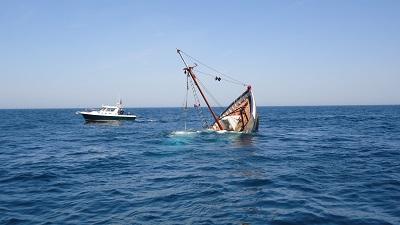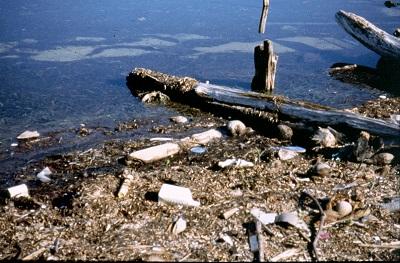Disposal of Vessels at Sea
Intentional ocean disposal of vessels generally should only be pursued when land-based alternatives are not available. Other options for managing old, outdated, and retired vessels include re-using the vessel or parts of the vessel, recycling or scrapping, preparation of the vessel for use as an artificial reef, and disposal of the vessel on land. The Marine Protection, Research and Sanctuaries Act (MPRSA) requires consideration of land-based alternatives prior to authorization of ocean disposal.
On this page:
- May a vessel be disposed at sea?
 The disposal of the fishing vessel Little Sandra in Region 1 (New England). Photo courtesy of Bill Lee, Master, OCEAN REPORTER.
The disposal of the fishing vessel Little Sandra in Region 1 (New England). Photo courtesy of Bill Lee, Master, OCEAN REPORTER. - Could vessel disposal at sea harm the
- How is a vessel prepared to comply with the general permit before disposal at sea?
- How are persons authorized to transport and dispose of a vessel at sea?
- Who in EPA's Regional Offices must be contacted about vessel disposal requests?
May a vessel be disposed at sea?
Vessels may be disposed at sea only under specified conditions in the MPRSA general permit published in the federal regulations at 40 CFR 229.3. Ocean disposal of a vessel that would not meet the general permit’s requirements would require a special permit.
The permit is most suitable for large ships with steel hulls. Smaller vessels are more amenable to land-based alternatives compared to larger ships; fiberglass vessels are more likely to contribute to marine debris. Between 0 and 10 vessels are disposed of in the ocean each year using the MPRSA general permit.
Could vessel disposal at sea harm the ocean?
Vessels, as well as items in and on vessels, can pose potential environmental, human health and navigational concerns. Vessels may contain harmful pollutants or serve as sources of pollution, such as oil, fuel, lubricants, polychlorinated biphenyls (PCBs), asbestos and floatable materials (e.g., plastics).
 Floating marine debrisSome vessels may not be suitable for ocean disposal because they may float or are likely to break apart and create marine debris. Vessel debris and floatable solids can be a navigational obstruction and safety hazard. Vessel debris can also physically destroy marine habitats and smother and entrap marine organisms. Fiberglass vessels may not be suitable for ocean disposal because fiberglass (fiber-reinforced plastic) can degrade or break apart, contributing to microplastic pollutant load and furthering marine pollution.
Floating marine debrisSome vessels may not be suitable for ocean disposal because they may float or are likely to break apart and create marine debris. Vessel debris and floatable solids can be a navigational obstruction and safety hazard. Vessel debris can also physically destroy marine habitats and smother and entrap marine organisms. Fiberglass vessels may not be suitable for ocean disposal because fiberglass (fiber-reinforced plastic) can degrade or break apart, contributing to microplastic pollutant load and furthering marine pollution.
How is a vessel prepared to comply with the general permit before disposal at sea?
Prior to disposal of a vessel at sea, qualified personnel are to remove, to the maximum extent practicable, all materials which may degrade the marine environment. This includes emptying and flushing all fuel lines and tanks, and removing from the hull other pollutants and readily detachable material capable of creating debris or contributing to chemical pollution.
Related Information:
- Guidance for vessels proposed for disposal at sea (International Maritime Organization Exit)
How are persons authorized to transport and dispose of a vessel at sea?
Interested persons must first notify the EPA Regional Office, for the Region responsible for the ocean waters where the proposed disposal will take place, at least one month prior to the planned vessel disposal. Contact information for EPA Regional Offices is provided below.
General instructions for an applicant wishing to dispose of a vessel at sea are listed below along with definitions of some of the terms used. EPA must be notified of specific information at successive increments of one month, 10 days, 48 hours and 12 hours before disposal of a vessel.
Applicant Instructions for Disposal of Vessels at Sea
- One Month EPA Notice: Except in an emergency situation (as determined by the local U.S. Coast Guard (USCG) Sector and/or the U.S. Army Corps of Engineers (USACE) District Office), at least one month before disposal of the vessel, the following information is provided in writing to the EPA Region responsible for the ocean waters in which the proposed disposal will take place. Copies of the notice should be sent to the Captain of the Port of the local USCG Sector and/or the USACE District Office, in order to facilitate efficient disposal under the permit.
- Need-for-disposal statement: discussion of the need for ocean disposal of the vessel.
- Vessel and cargo description: type and description of vessel (including vessel's name and registration number) and type of cargo normally carried.
- Disposal plan: detailed description of proposed disposal procedures (including proposed location) and requested date of disposal.
- Environmental impact: information on the potential effect of disposal on the marine environment.
- Disposal alternatives: documentation of an adequate evaluation of alternatives to ocean disposal. The alternative methods of disposal that must be considered are scrap, salvage and reclamation. Use as an artificial reef site should be considered.
- USCG supervision: The District Commander of USCG or his designee may supervise transportation to the disposal site.
- Measures for removing pollutants: Except in an emergency situation (as determined by the local USCG Sector and/or USACE District Office), prior to disposal, qualified personnel must remove all materials, to the maximum extent practical, that may degrade the marine environment. The measures include, but are not limited to:
- emptying all fuel lines and fuel tanks to the lowest point practicable, flushing them with water, and again emptying them to the lowest point practicable so that they are essentially free of petroleum; and
- removing from the hulls other pollutants and all readily detachable material capable of creating debris or contributing to chemical pollution.
- Ten day notice to EPA and USCG: Except in an emergency situation (as determined by the local USCG Sector and/or USACE District Office), at least 10 days before disposal, notify EPA and District Commander of USCG that the vessel has been cleaned and is available for inspection. The vessel may be transported for dumping only after EPA and USCG agree that the requirements of paragraph 3 of the permit have been met.
- Disposal site location:
- Disposal of the vessel has to take place:
- in a site designated on current National Oceanic and Atmospheric Administration (NOAA) charts for the disposal of wrecks; or
- at least 12 nautical miles from the nearest land and in water at least 300 feet deep.
- Disposal cannot take place in:
- established shipping lanes unless at a designated wreck site;
- a marine sanctuary; or
- a location where the hulk may present a hazard to commercial trawling or national defense.
- Disposal of the vessel has to take place:
- Vessel preparation: All necessary measures must be taken to ensure that marine navigation is not otherwise impaired and that the vessel sinks to the bottom rapidly. The towing vessel must remain at the disposal site for at least two hours to confirm that no large portions of the disposed vessel rise to the surface or to recover any floating scrap material.
- Disposal times: Except in an emergency situation (as determined by the local USCG Sector and/or USACE District Office), disposal can only take place during daylight hours.
- Forty-eight and 12 hour notice to Captain-of-the Port (COTP), USCG and EPA: Except in an emergency situation (as determined by the local USCG Sector and/or USACE District Office), the COTP, USCG and EPA must be notified 48 hours in advance of disposal. In addition, the COTP and EPA must be notified by telephone at least 12 hours before the vessel’s departure from port with such details as:
- the proposed departure time and place;
- disposal site location;
- estimated time of arrival on site; and
- name and communication capability of the towing vessel. Schedule changes are to be reported to the COTP as rapidly as possible.
- NOS notification of disposal site coordinates: EPA and the National Ocean Service (NOS) office of NOAA must be notified in writing within one week of the exact coordinates of the disposal site so that it may be marked on the appropriate charts.
- Contact: Nautical Data Branch, N/CS26, Room 7317, 1315 East-West Highway, Silver Spring, MD 20910-3282.
Who in EPA's Regional Offices must be contacted about vessel disposal requests?
Please visit our Regional Contacts List for contact information.
